Discover 35 hidden attractions, cool sights, and unusual things to do in Quezon City (Philippines). Don't miss out on these must-see attractions: Santo Domingo Church, Smart Araneta Coliseum, and Church of the Gesù. Also, be sure to include Fairview Terraces in your itinerary.
Below, you can find the list of the most amazing places you should visit in Quezon City (Metropolitan Manila).
Table of Contents
Santo Domingo Church
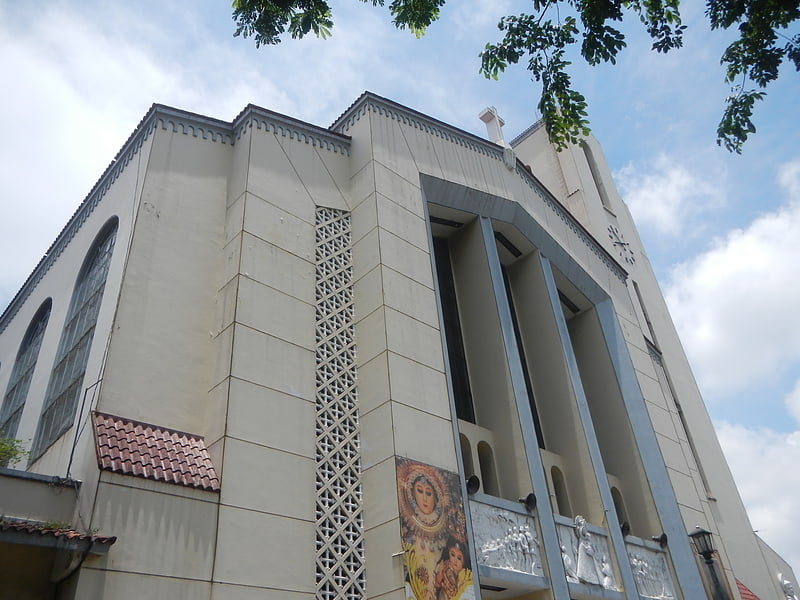
Catholic church in Quezon City, Philippines. Santo Domingo Church, formally known as the National Shrine of Our Lady of the Most Holy Rosary, is the largest church in Metro Manila and one of the biggest churches in Asia. It is dedicated to Mary, mother of Jesus under her title Our Lady of the Most Holy Rosary.
This is the sixth church complex that has served as the motherhouse or headquarters of the Dominican Order of the Philippines. The Dominicans were one of the "pioneering missionaries" of the Philippines. The motherhouse was transferred to the Quezon City location after the Manila location was destroyed during World War II in the Philippines.[1]
Address: 537 Quezon Ave, 1100 Quezon City (Quezon City District 1)
Smart Araneta Coliseum
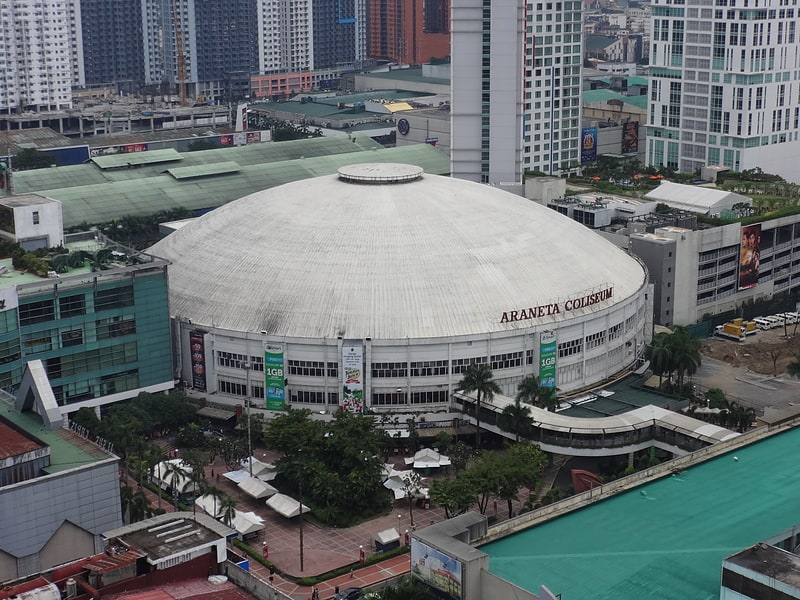
Coliseum in Quezon City, Philippines. The Araneta Coliseum, officially the Smart Araneta Coliseum due to sponsorship reasons, is an indoor multi-purpose sports arena that is part of the Araneta City in the Cubao area of Quezon City, Philippines. Nicknamed "the Big Dome", it is one of the largest indoor arenas in Asia, and it is also one of the largest clear span domes in the world. The dome measures approximately 108.0 meters making it the largest dome in Asia from its opening in 1960 until 2001 when it was surpassed by the Ōita Stadium in Japan with a dome measuring 274.0 meters.
The Smart Araneta Coliseum is mostly used for sports such as basketball. It is a main venue of the Philippine Basketball Association and for the basketball games of the National Collegiate Athletic Association and the University Athletic Association of the Philippines. The Big Dome is also used for boxing, cockfighting, local and international concerts, circuses, religious gatherings, beauty pageants and more.[2]
Address: Gen. Araneta St, 1109 Quezon City (Quezon City District 3)
Church of the Gesù
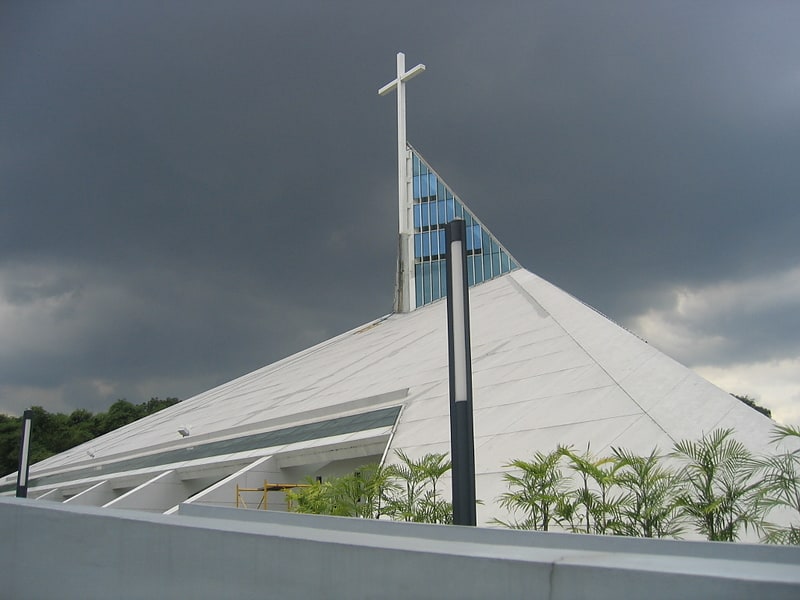
Iconic church known for its design. The Church of the Gesù is the Roman Catholic church of the Ateneo de Manila University campus in Quezon City in the Philippines. The landmark was designed by Jose Pedro Recio and Carmelo Casas. The edifice’s massive triangular structure symbolizes the Holy Trinity, as well as the three-fold mission and vision of the school. Its shape and design are also meant to suggest the outstretched arms of the Sacred Heart, and the traditional Filipino bahay kubo. The site has a total area of 10,200 square metres and seating capacity for 1,000 persons. The church is situated on Sacred Heart Hill, a small hill overlooking Bellarmine Field, believed to be the highest point in Loyola Heights. In its immediate vicinity are the dormitories and the John Pollock Renewal Center. The peak cross and carillon of the church can be seen from Katipunan Avenue, which borders the campus to the west.
One side of the church houses a chapel dedicated to the Virgin Mary as the Immaculate Conception, patroness of Ateneo de Manila and of the Philippines, while another side chapel is dedicated to the Sacred Heart of Jesus, a devotion committed to the Jesuits by Jesus's appearances to Saint Margaret Mary Alacoque at a convent in Paray-le-Monial in 1671.
In front of the church is a Sacred Heart statue depicting Jesus with welcoming, outstretched arms. At the base of the statue is an inscription from Matthew 11:28: "Come to me all of you who are burdened, and I will refresh you. Take my yoke upon you and learn from me, for I am meek and gentle of heart, thus you will find refreshment for your souls. My yoke is sweet and my burden light." The small field to the north of the church has a statue depicting the Agony in the Garden.[3]
Address: Fr. Materson Dr, Ateneo De Manila University, 1108 Quezon City (Quezon City District 3)
Fairview Terraces
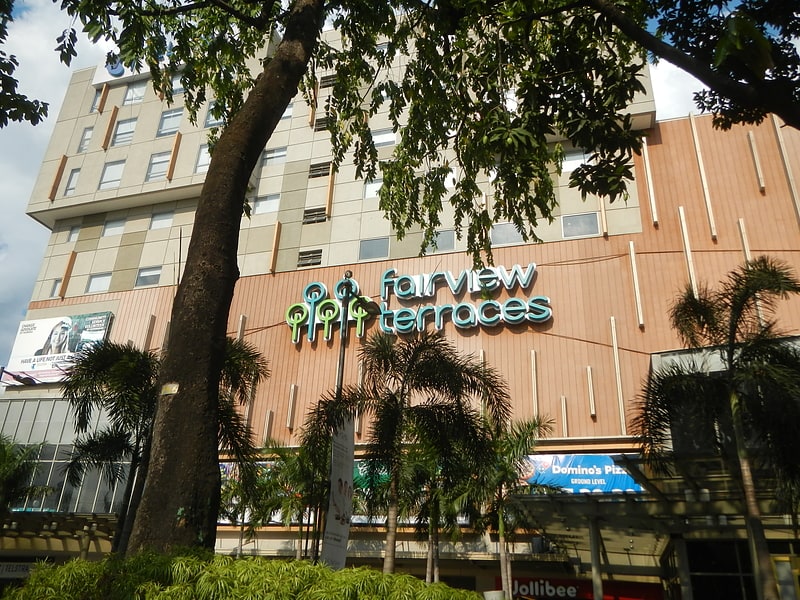
Shopping mall in Quezon City, Philippines. Fairview Terraces is a shopping mall in Quezon City, the Philippines, owned by the Ayala Malls group. It opened on February 28, 2014 and has a floor area of 114,000 m2, making it the third largest Ayala Mall after TriNoma and U.P. Town Center.[4]
Address: Quezon City, Quirino Highway cor. Maligaya Drive
Oblation Statue
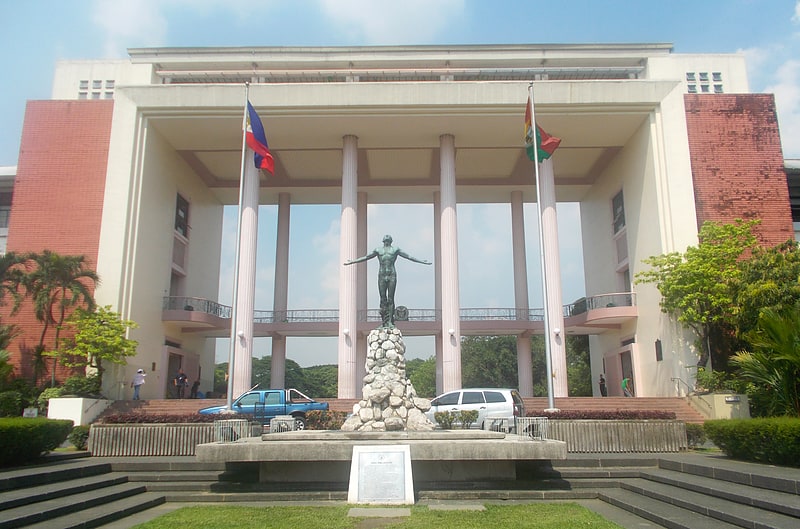
The Oblation is a concrete statue by Philippine National Artist artist Guillermo Tolentino which serves as the iconic symbol of the University of the Philippines. It depicts a man facing upward with arms outstretched, symbolizing selfless offering of oneself to his union.[5]
Address: University Ave., 1101 Quezon City (Quezon City District 4)
Novaliches Cathedral
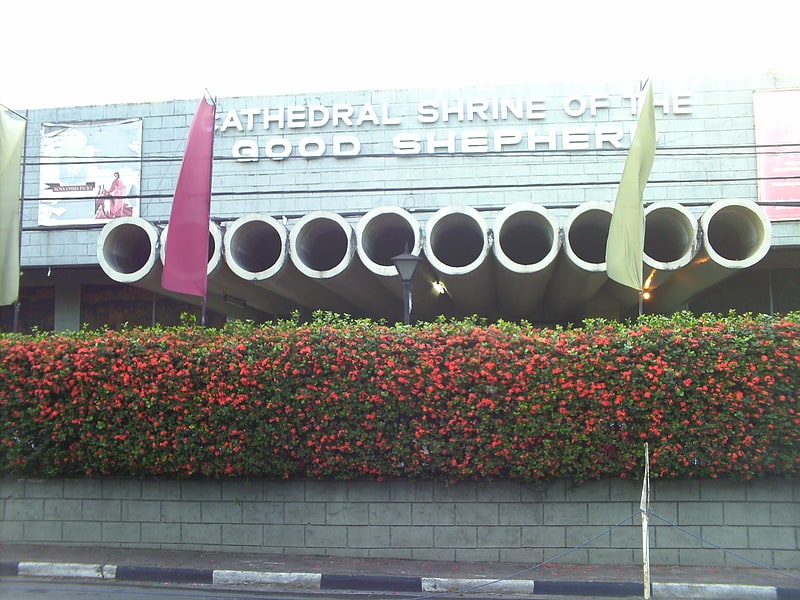
Church. Novaliches Cathedral, canonically recognized as the Cathedral-Shrine and Parish of the Good Shepherd, is a Roman Catholic church located along Regalado Avenue in Barangay Fairview, Quezon City in the Philippines. It is the seat of the Diocese of Novaliches. It was established on August 5, 1975 by Manila Archbishop Jaime L. Cardinal Sin, who designated Rev. Fr. Fidelis Ruben Limcaco as the church's first parish priest.
From 1975 to 2003, the Good Shepherd Archdiocesan Shrine was a part of the Archdiocese of Manila. It was elevated into the status of cathedral when it was designated to be the seat of the newly created Diocese of Novaliches in January 2003. Rev. Msgr. Jesus-Romulo C. Rañada, PC became the first cathedral rector. Since 2019, Rev. Fr. Antonio E. Labiao Jr. VG has been the pastor and rector.[6]
Address: Good Shepherd Convent 1043 Aurora Blvd, Quezon City (Quezon City District 3)
Vargas Museum
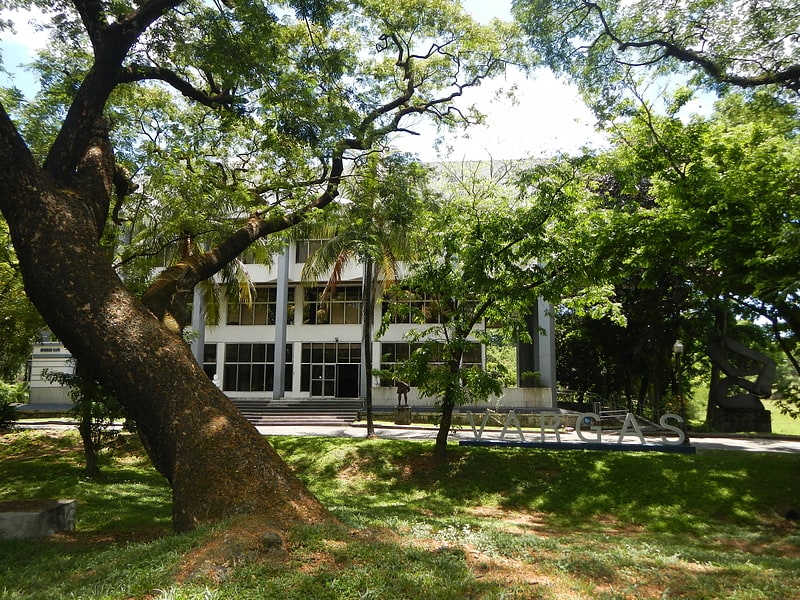
Museum in Quezon City, Philippines. The Jorge B. Vargas Museum & Filipiniana Research Center, simply known as the UP Vargas Museum, is a museum located at the University of the Philippines Diliman campus which houses the collection of art, stamps and coins, library, personal papers and memorabilia of Jorge B. Vargas which he bequeathed to the university. It is under the management of the UP Diliman College of Arts and Letters.[7]
Address: UP Diliman, 1101 Quezon City (Quezon City District 4)
Tandang Sora Memorial Shrine

The Tandang Sora National Shrine is a national monument and memorial park in Quezon City, Metro Manila, Philippines. It is dedicated to Filipino revolutionary and centenarian, Melchora Aquino who is also known as "Tandang Sora".[8]
Basilica Minore de Santuario de San Pedro Bautista
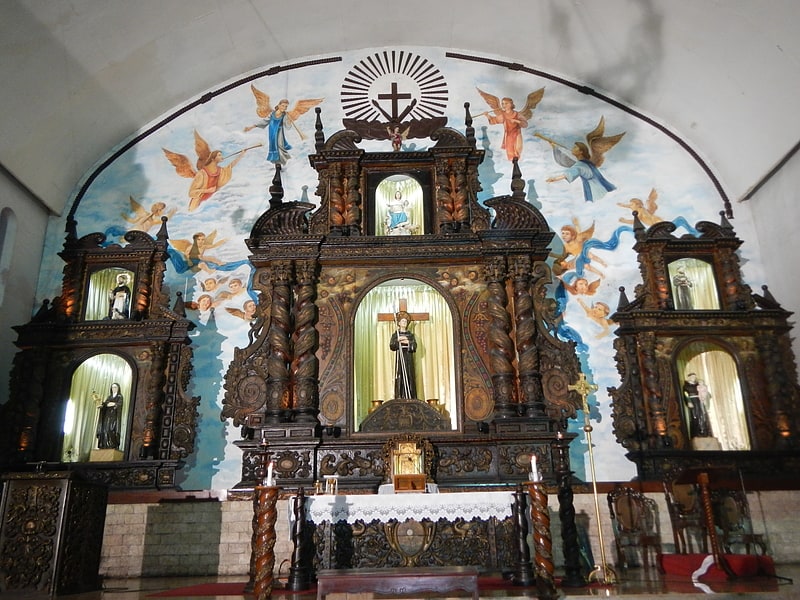
Parish church in Quezon City, Philippines. The Basilica Menor de San Pedro Bautista, also known as the San Francisco del Monte Church is a parish church in the San Francisco del Monte district of Quezon City, in the Philippines. It is one of the oldest churches in the country having founded in 1590. The church is dedicated to its founder Padre Pedro Bautista, a Spanish missionary from Ávila, Spain, one of the 26 Christians martyred in Japan in 1597.
The shrine belongs to the Diocese of Cubao under the Vicariate of Saint Pedro Bautista. It is also under the administration of the Franciscans or the Order of Friars Minor (OFM), from the Franciscan Province of Saint Pedro Bautista.[9]
Address: 69 San Pedro Bautista SF.DM, 1104 Quezon City (Quezon City District 1)
AFP Museum

Museum in Quezon City, Philippines. The Armed Forces of the Philippines Museum, also known as the AFP Museum is a military museum located within the premises of Camp Aguinaldo in Quezon City, Philippines.[10]
Millennium Transmitter
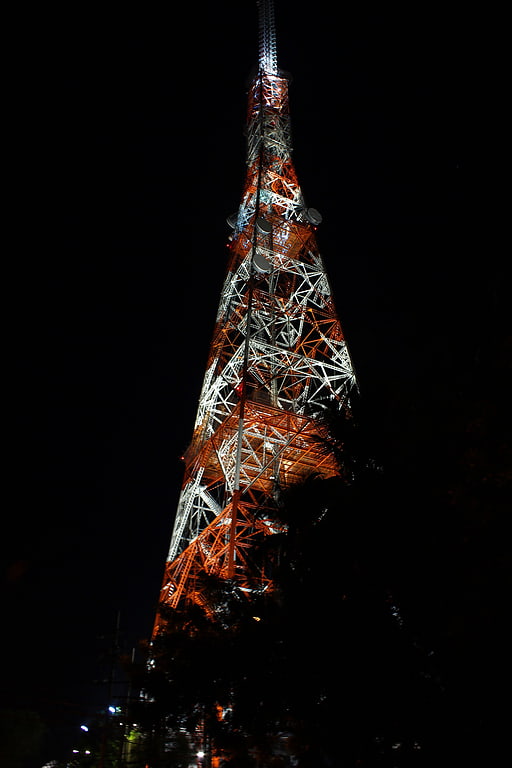
The Millennium Transmitter is a 720 ft tall mast owned by the ABS-CBN Corporation located at the ABS-CBN Broadcast Center, Mother Ignacia Street corner Sgt. Esguerra Avenue, Quezon City. It served as a platform for television transmission for both DWWX-TV and DWAC-TV, the respective flagship stations of ABS-CBN and ABS-CBN Sports and Action. It was also the former transmission tower of radio station DWRR until it was shifted when the Millennium Transmitter was upgraded by the end of 1999. On June 30, 2020, the transmitter was completely shut off due to a cease and desist order from the National Telecommunications Commission after ABS-CBN's legislative franchise expired on May 4, 2020.[11]
EDSA Shrine
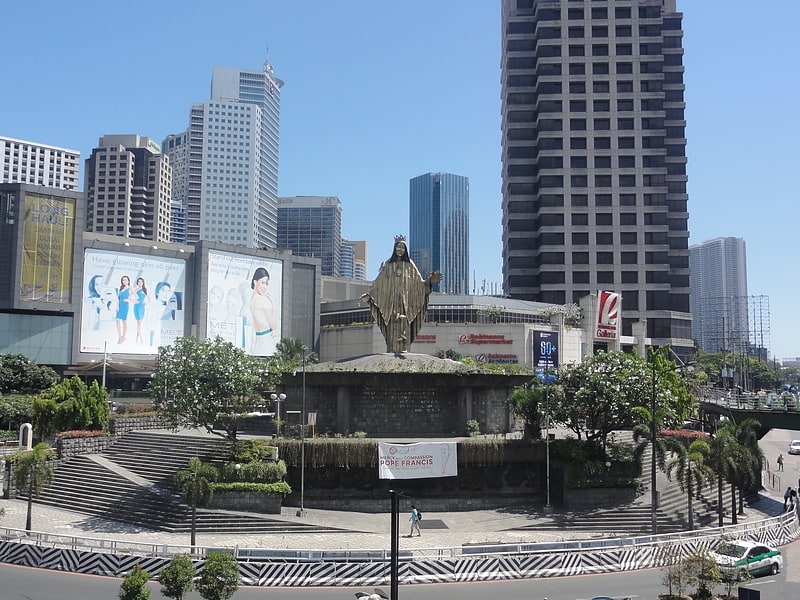
Shrine in Quezon City, Philippines. The Shrine of Mary, Queen of Peace, Our Lady of EDSA, or more popularly, the EDSA Shrine is a small church of the Roman Catholic Archdiocese of Manila located at the intersection of Ortigas Avenue and Epifanio de los Santos Avenue in Barangay Ugong Norte, Quezon City. The church is also called the Archdiocesan Shrine of Mary, Queen of Peace or Mary, Queen of Peace Quasi-Parish, although these names are seldom used. It is also a declared Important Cultural Property by the National Commission for Culture and the Arts.
Built in 1989 on donated land to commemorate the People Power Revolution, the shrine is the site of two peaceful demonstrations that toppled Presidents Ferdinand Marcos in 1986, and Joseph Estrada.
The EDSA Shrine is the northernmost tip of the Ortigas Center, a financial and commercial district occupying large tracts of land in Quezon City, Mandaluyong, and Pasig.[12]
Address: Epifanio delos Santos Ave., 2420 Quezon City (Quezon City District 3)
Quezon Memorial Shrine

Museum in Quezon City, Philippines. The Quezon Memorial Shrine is a monument and national shrine dedicated to former Philippine President Manuel Quezon located within the grounds of Quezon Memorial Circle in Quezon City, Metro Manila. It also houses a museum at its base.[13]
Address: Quezon Avenue, Quezon City (Quezon City District 4)
PAGASA Observatory
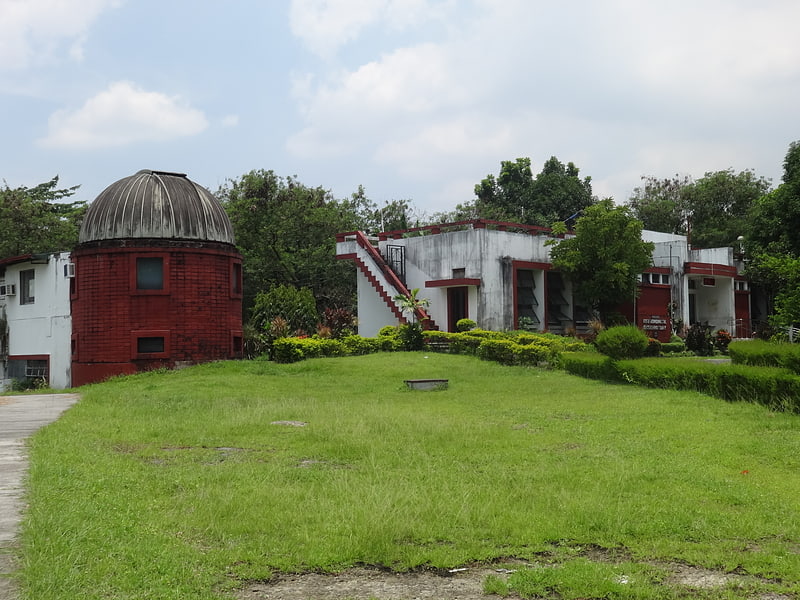
The PAGASA Astronomical Observatory also known as the PAGASA Observatory is an astronomical observatory in Quezon City, Metro Manila, Philippines within the University of the Philippines Diliman campus. Established in 1954 and managed by the Philippine Atmospheric, Geophysical and Astronomical Services Administration, the facility hosts the largest operational telescope in the Philippines.
The facility's Observatory dome hosts a computer-based 45 cm (1.48 ft) Cassegrain reflector telescope which was donated by the Japanese government through a cultural aid grant and installed at site in May 2001. Prior to this period, the Observatory used a 30 cm (0.98 ft) reflector-type telescope. The current telescope is often used for CCD imaging of stars.
The PAGASA Observatory was opened for public use on February 16, 2003, during the start of the National Astronomy Week.[14]
Parish of the Holy Sacrifice
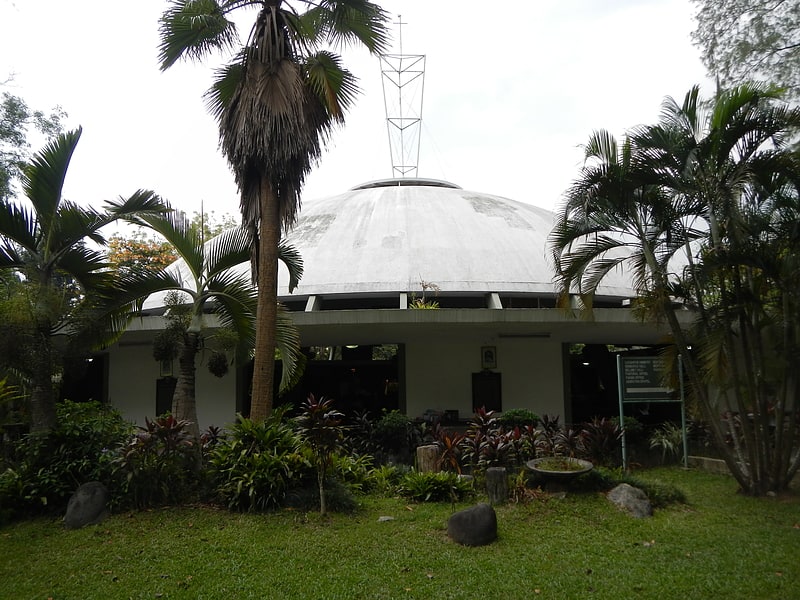
Chapel in Quezon City, Philippines. The Parish of the Holy Sacrifice, also known as the Church of the Holy Sacrifice, is a landmark Catholic chapel on the University of the Philippines Diliman campus. It belongs to the Roman Catholic Diocese of Cubao and its present parish priest is Rev. Fr. Jose S. Tupino III. More popularly known as the UP Chapel, the church was constructed under the supervision of Fr. John P. Delaney, who began ministering to the spiritual needs of the campus in 1947.
Known for its architectural design, the church is recognized as a National Historical Landmark and a Cultural Treasure by the National Historical Commission of the Philippines, and the National Museum of the Philippines respectively. It was designed by the late National Artist of the Philippines for Architecture, Leandro Locsin, one of four National Artists who collaborated on the project. According to a post from the UP Diliman website, it is the only structure in the country where the works of five national artists can be found. Alfredo Juinio served as the structural engineer for the project.
The church is adjacent to the U.P. Health Service Building and the U.P. Shopping Center, and is serviced by all of the university's jeepney routes.[15]
Address: Laurel Ave, University of the Philippines, Diliman, 1101 Quezon City (Quezon City District 4)
Socorro Water Towers
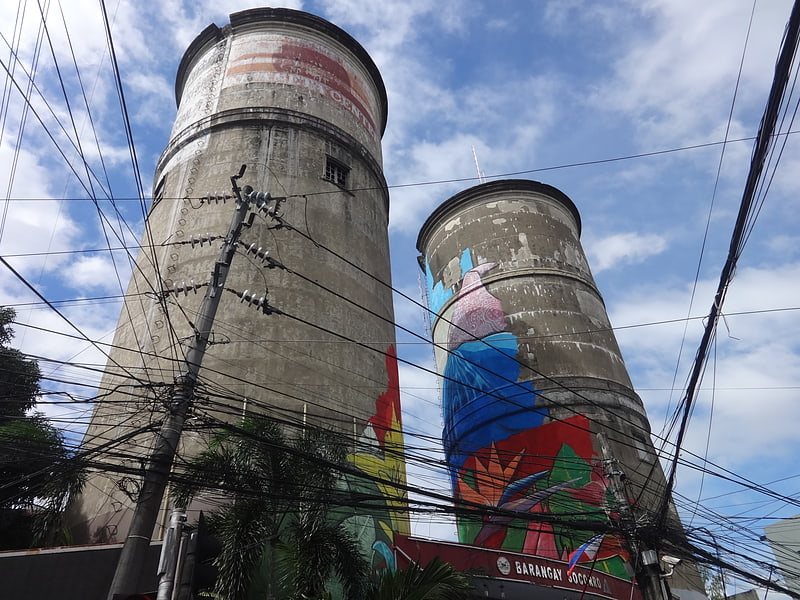
The Socorro Water Towers are historic water towers in the barangay of Socorro in Quezon City, Metro Manila, Philippines.[16]
Address: 15th Ave, Cor. Col. Bonny Serrano Ave, Quezon City (Quezon City District 3)
Kia Theatre
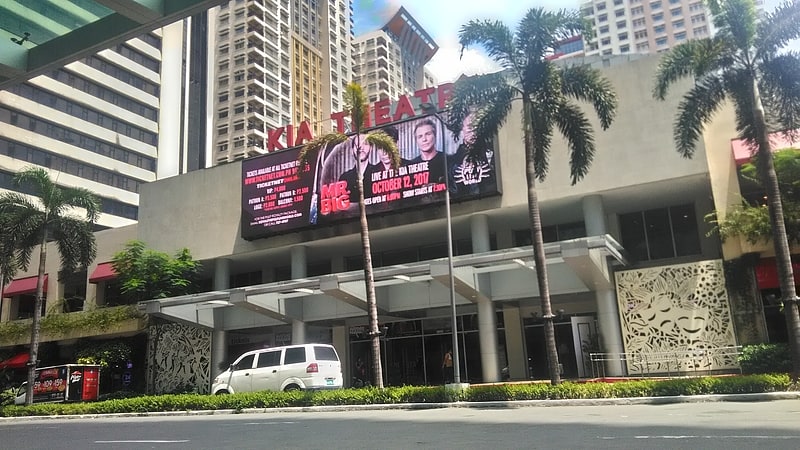
Theater. The New Frontier Theater, known as the Kia Theatre between 2015 and 2018, is a multi-purpose events hall in the Araneta City in Cubao, Quezon City, Metro Manila, Philippines. The theater has a 2,385 seating capacity and is used for a variety of events, ranging from performing and visual arts, local and international concerts, and fan meet-up gatherings.[17]
Address: Quezon City, Gen. Emilio Aguinaldo Avenue, Araneta City
Ninoy Aquino Parks and Wildlife Center
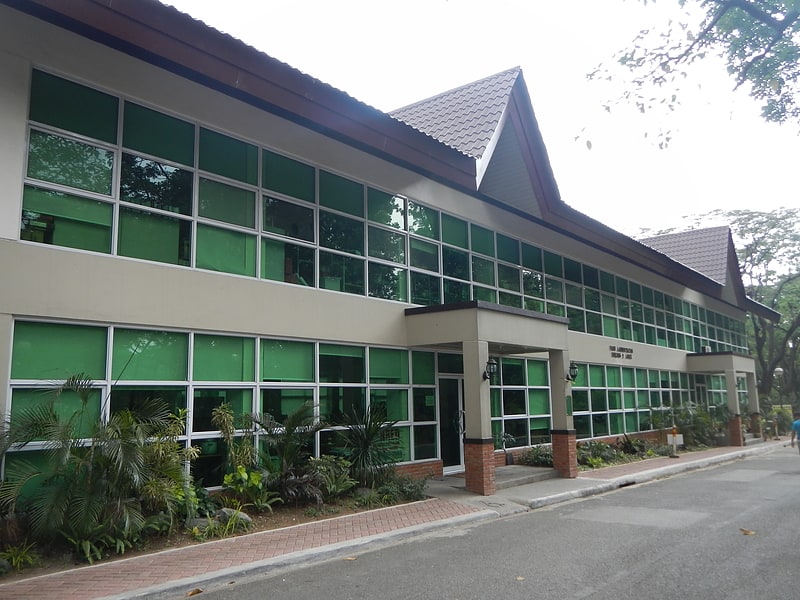
Zoological garden in Quezon City, Philippines. The Ninoy Aquino Parks and Wildlife Center is a 22.7-hectare zoological and botanical garden located in Diliman, Quezon City, Philippines. It was named after Benigno "Ninoy" Aquino Jr. The Ninoy Aquino Parks & Wildlife Center has a lagoon, an aquarium, a playground, botanical garden and a Wildlife Rescue Center, which the Department of Environment and Natural Resources uses as a temporary shelter where confiscated, retrieved, donated, sick, abandoned, and injured wild animals are placed to be taken care of. The park houses several indigenous plants and animals such as crab-eating macaques, water monitors, Philippine deer, binturongs, Palawan bearded pigs and several varieties of birds.[18]
Address: Elliptical Road, 1101 Quezon City (Quezon City District 1)
Lourdes Snack
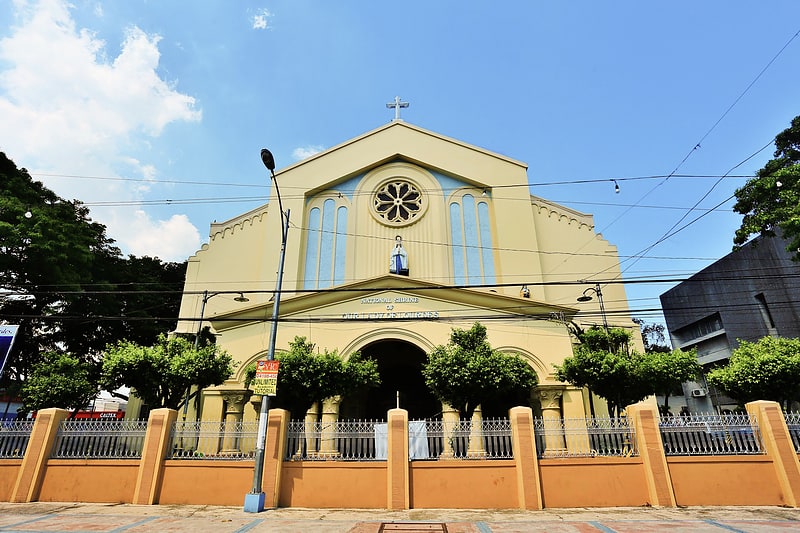
Catholic church in Quezon City, Philippines. The National Shrine of Our Lady of Lourdes, better known as Lourdes Church, is a Roman Catholic national shrine in Quezon City, Philippines. The church is administered by the Order of Friars Minor Capuchin of the Philippine Ecclesiastical Province and under the Vicariate of San Pedro Bautista of the Diocese of Cubao.
The original church was located in Intramuros until it was destroyed during the Second World War. The venerated Marian image enshrined within dates from 1894 was hidden and spared during the bombing. The present church was completed and inaugurated in 1951. In 1997, it was declared as a national shrine by the Catholic Bishops' Conference of the Philippines.
Dedicated to Our Lady of Lourdes, the church celebrates its feast on 11 February. Pope Francis granted a decree of Canonical coronation towards the image in 5 September 2019. The image was crowned on 22 August 2020.[19]
Address: N.S. Amoranto Sr. St, 1114 Quezon City (Quezon City District 1)
Manila Observatory
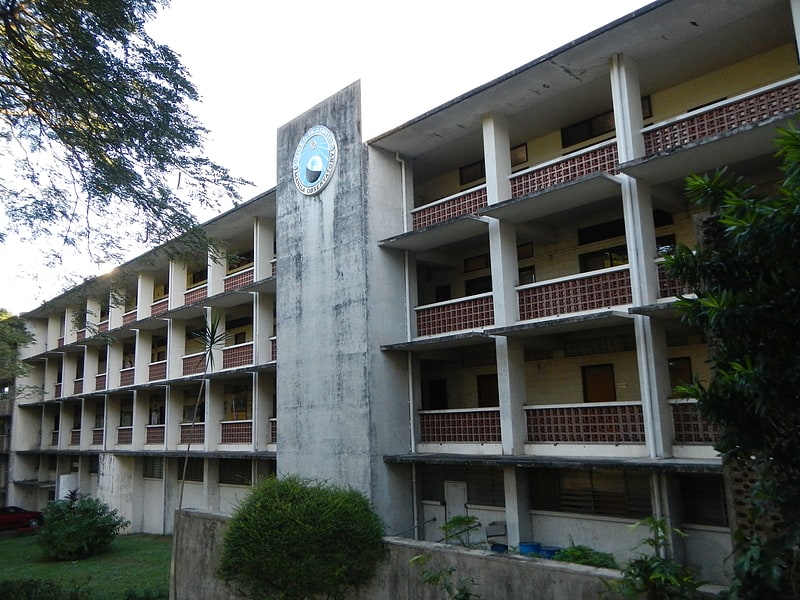
Non-profit. The Manila Observatory is a non-profit research institute housed on the campus of the Ateneo de Manila University in Quezon City, Philippines. It was founded by the Society of Jesus, commonly known as the Jesuits, in 1865 as the Observatorio Meteorológico del Ateneo Municipal de Manila. It was later renamed Observatorio Meteorológico de Manila. It has done weather forecasting and earthquake research and today researches seismic and geomagnetic phenomena as well as radio and solar physics.[20]
Quezon Heritage House
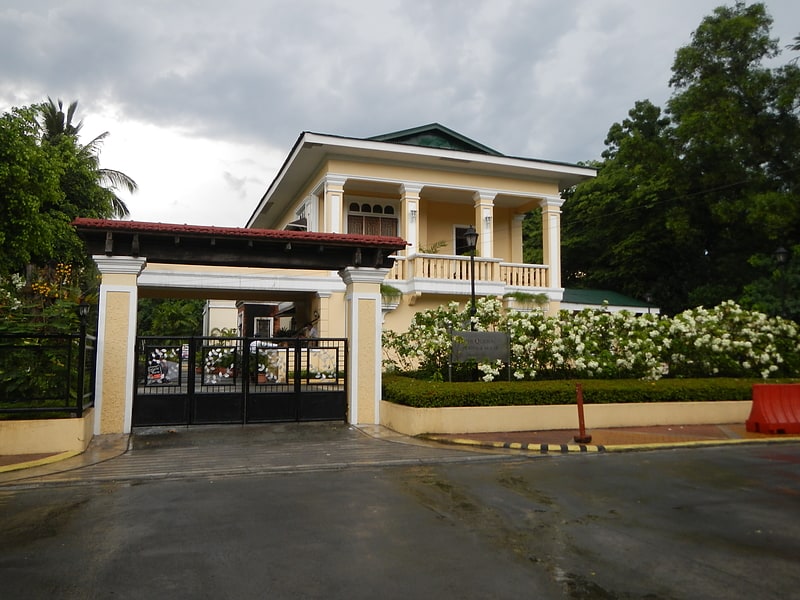
Museum in Quezon City, Philippines. The Quezon Heritage House is a historic house museum within the grounds of the Quezon Memorial Circle in Quezon City, Philippines. It is situated across the Quezon City Hall.[21]
Address: Quezon memorial circle, Quezon City (Quezon City District 4)
11th World Scout Jamboree Memorial Rotonda

Monument in Quezon City, Philippines. The 11th World Scout Jamboree Memorial Rotonda, also known as the Boy Scout Circle, is a roundabout in Quezon City, Metro Manila, the Philippines. Located at the intersection between Timog and Tomas Morato Avenues, it serves as the boundary between Barangays South Triangle, Laging Handa and Sacred Heart.
A monument stands in the middle of the roundabout which commemorates the members of the ill-fated Philippine contingent to the 11th World Scout Jamboree that was among the casualties of the United Arab Airlines Flight 869 crash of 1963. The monument consists of a circular pedestal with bronze statues in the likenesses of the 24 members of the Philippine delegation (22 Boy Scouts, 2 veteran Scouters, and 2 chaperons) positioned around the structure.
The statues were sculpted by Florante Beltran Caedo and the monument was unveiled to the public in 1965 by then Mayor Norberto S. Amoranto at the intersections of Sampaloc and South avenues (now Tomas Morato and Timog avenues, respectively). In 2007, the Quezon City government performed a ₱20 million renovation on the monument that included the addition of an obelisk on top of the structure honoring Tomás Morató, the first mayor of Quezon City and after whom the Tomas Morato Avenue is named.[22]
Manila Philippines Temple

Temple in Quezon City, Philippines. The Manila Philippines Temple is a temple of The Church of Jesus Christ of Latter-day Saints in Quezon City, Philippines. It is the 29th operating temple of the LDS Church.[23]
Address: 13 Temple Drive, Quezon City (Quezon City District 3)
INC Central Temple
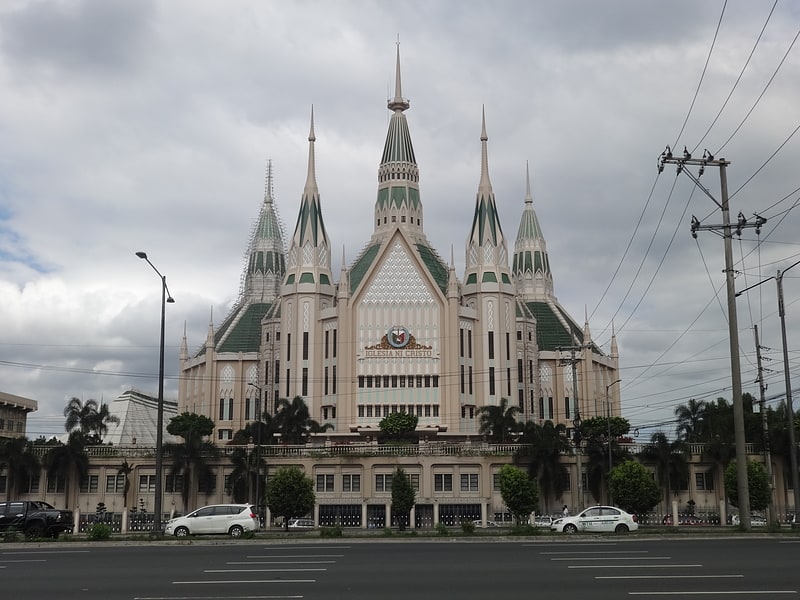
Temple. The Iglesia ni Cristo Central Temple is a main temple of the Philippine-based Christian religion, the Iglesia ni Cristo. Located along Commonwealth Avenue in Quezon City, it was completed on July 27, 1984, and is the biggest church/place of worship in the whole country for all religions as per the dimensions are concerned with a capacity of around 7,000 people.[24]
Quezon City Experience
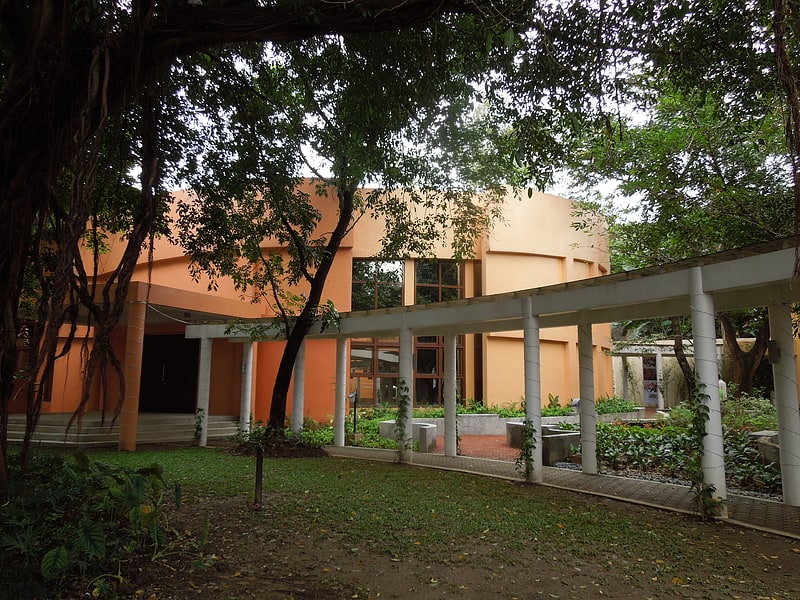
Museum in Quezon City, Philippines. The Quezon City Museum Complex, more commonly known as the QCX Museum or the Quezon City Experience Museum is an interactive and socio-cultural green building-compliant city museum which was inaugurated on November 9, 2015, within the Quezon Memorial Circle in Quezon City, Metro Manila, Philippines. QCX primarily displays the history and culture of Quezon City. It is touted as the first interactive museum of the city. The museum concept was conceived in 2006.[25]
Address: Quezon Memorial Circle, Quezon City (Quezon City District 4)
Circulo Verde
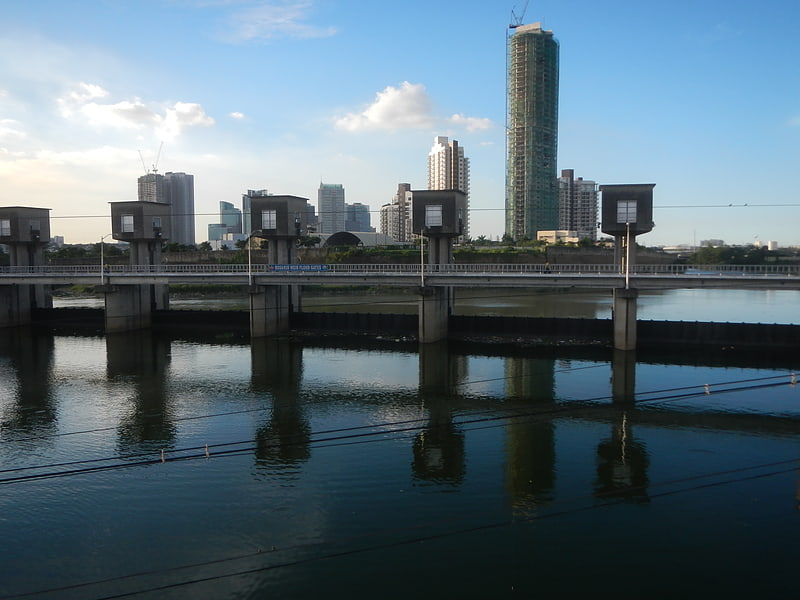
Mixed-use development. Circulo Verde is a mixed-use development in Quezon City, Metro Manila, the Philippines. It is a primarily residential enclave on a meander of the Marikina River in the village of Bagumbayan on Quezon City's border with Pasig. The 12.47-hectare riverfront community is a redevelopment of the former cement plant owned by Concrete Aggregates Corp. a subsidiary of Ortigas & Company. It is one of the four major estates owned and developed by the company in Metro Manila, which in 2019 maintained a combined land bank of 50 hectares across the Eastern Manila cities of Mandaluyong, Pasig and Quezon City.[26]
Ateneo de Manila University
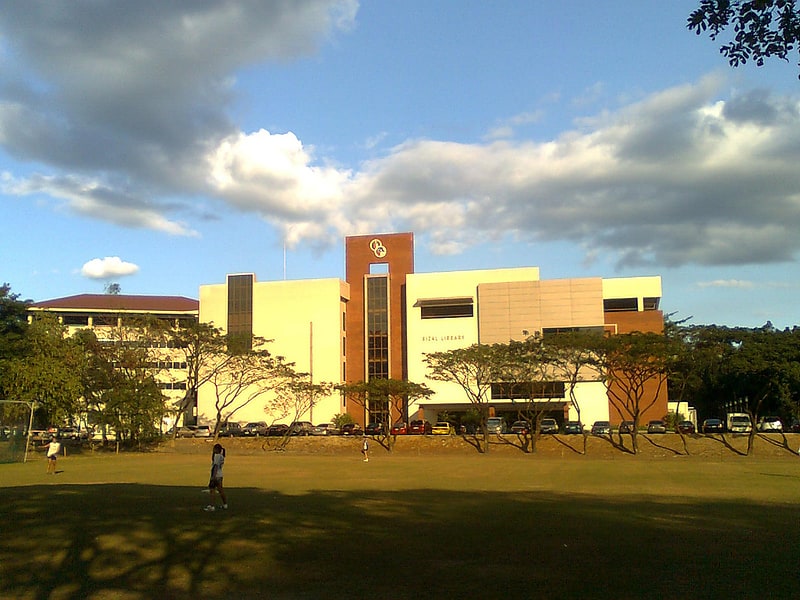
Private university in Quezon City, Philippines. The Ateneo de Manila University, also known simply as the Ateneo de Manila, the Ateneo, or AdMU, is a private, research, basic and higher education institution founded and run by the Society of Jesus in Quezon City, Philippines. Founded in 1859 as Escuela Municipal de Manila, it is the second-oldest Jesuit-administered institution of higher learning in Asia-Pacific.
The university provides primary and secondary education as well as undergraduate and graduate instruction in the humanities, social sciences, natural sciences and engineering, and business. It offers professional degrees through the Graduate School of Business, the School of Government, the School of Medicine and Public Health, and the Ateneo Law School. Known for its Jesuit liberal arts tradition, the humanities are a key feature of Ateneo education at all levels of study. This is especially pronounced in the undergraduate level as the Core Curriculum.
The Ateneo is widely regarded and often cited as the highest-ranked private university and second overall in the country and admission is highly selective.[27]
Address: Ateneo de Manila University, 1108 Quezon City (Quezon City District 3)
Cathedral of St. Mary and St. John

Cathedral in Quezon City, Philippines. The Cathedral of St. Mary and St. John is an Anglican church in Quezon City, Metro Manila, Philippines. It serves as the National Cathedral of the Episcopal Church in the Philippines.
It was established by Bishop Charles Henry Brent from the then Protestant Episcopal Church of the United States of America initially catering to American and European expatriates in the Philippines. It later also served Filipinos. The groundbreaking of the original church building in Manila situated near Isaac Peral Street was made on January 25, 1905. The construction finished in 1907. The building funded through donations cost at least $120 thousand.
The building was seized by the Japanese on July 8, 1944 during the Japanese occupation of the Philippines amidst World War II and was used as an internment camp. It was destroyed during the Battle of Manila of 1945. The Manila Pavilion Hotel currently occupies the old site.
Bishop Lyman C. Ogilby held talks with John Van Wie Bergamini, the veteran architect of the Episcopal Church throughout the Far East in 1954 in America which led to the construction of the structure currently occupied by the cathedral which was consecrated on February 9, 1962.[28]
Address: 277 E Rodriguez Sr. Ave, Quezon City (Quezon City District 4)
Bernardo Park
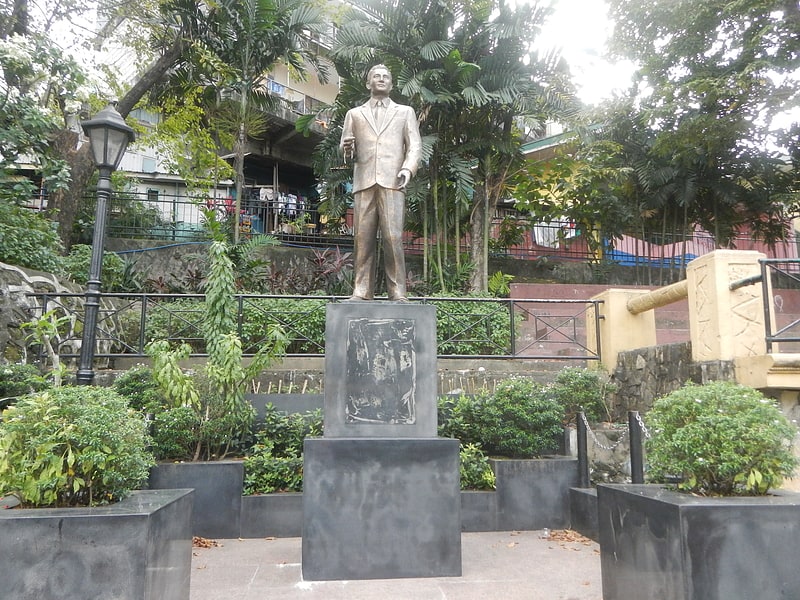
Park in Quezon City, Philippines. Bernardo Park is an urban community park located on both banks of the Diliman Creek in Quezon City, Metro Manila, Philippines. It is the first public park in Quezon City which opened in 1948. The park is the social and cultural center of the barangay of Pinagkaisahan and the largest park in the barangay of Kamuning. It was named after Ponciano Bernardo, the second mayor of Quezon City who was also the city's first vice-mayor and city engineer appointed by President Manuel L. Quezon.[29]
Quezon City Hall
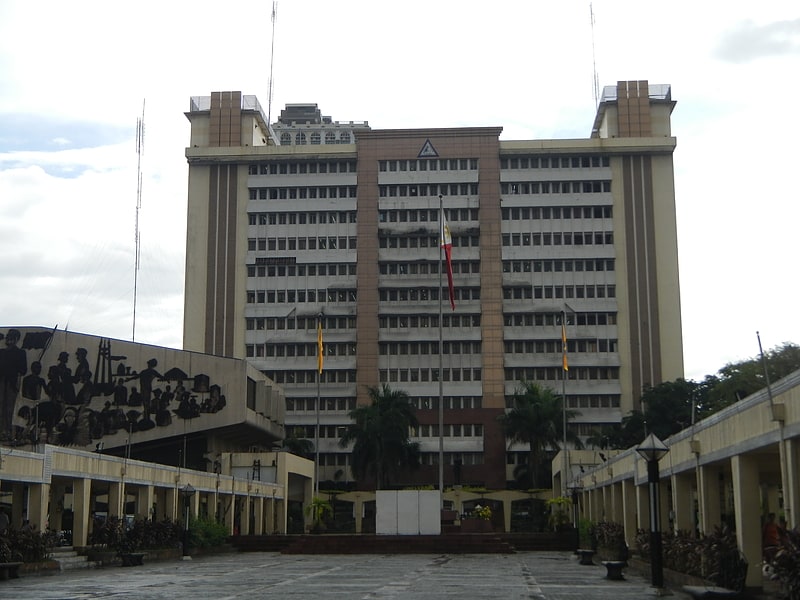
Building in Quezon City, Philippines. The Quezon City Hall is a government building which houses the office of the Mayor of Quezon City located along the Elliptical Road. The Quezon City Council is housed within the adjacent Legislative Wing.[30]
Bantayog ng mga Bayani Center

Memorial park in Quezon City, Philippines. The Bantayog ng mga Bayani, sometimes simply referred to as the Bantayog, is a monument, museum, and historical research center in Quezon City, Philippines, which honors the martyrs and heroes of the struggle against the 21-year dictatorship of former President Ferdinand Marcos.[31]
Balara Filters Park

Park in Quezon City, Philippines. The Balara Filters Park is a 60-hectare park located in the Diliman village of Pansol in Quezon City, Metro Manila, Philippines, adjacent to the University of the Philippines Diliman main campus. It is bounded by Katipunan Avenue on the west, Capitol Hills Golf and Country Club on the north, and the upscale, gated village of La Vista along its south and east.
The park is one of the oldest recreation areas in Quezon City having been first opened to the public in 1953. It occupies part of the old Balara Filtration Plant complex, one of the main treatment facilities for water coming from the La Mesa Dam. The park is administered by the Manila Water company in partnership with the Quezon City Parks Development and Administration Department.[32]
UP Diliman AGT

The University of the Philippines Diliman AGT was an automated guideway transit system constructed for technology demonstration within the campus of the University of the Philippines in Diliman, Quezon City in the Philippines. It served as a test track for the first mass transit system to be built and developed in the country by local engineers.
The first phase of the project was funded by the Department of Science and Technology (DOST) in a joint project with the UP administration. DOST provided funding and supervised the first phase as well as the design of the coaches and track to be used. If found feasible, the project would be expanded into a 6.9-kilometre (4.3 mi) intracampus loop. In October 2018, the DOST announced that it would dismantle the railway line and transfer it to another university after UP declined use of the facility.[33]
La Mesa Watershed Reservation

Park in Quezon City, Philippines. The La Mesa Watershed Reservation is a protected area that preserves the only major watershed in Metro Manila, Philippines. Also known as the Novaliches Watershed, it contains the last remaining rainforest of its size in Metro Manila surrounding the La Mesa Dam and Reservoir, the primary source of potable drinking water for 12 million residents in the Manila metropolitan area. The area is under the joint administration, supervision and control of the Department of Environment and Natural Resources and the Metropolitan Waterworks and Sewerage System. It was established in 2007 through Proclamation No. 1336 issued by President Gloria Arroyo.[34]
North Avenue

Road in Quezon City, Philippines. North Avenue is a major road located in Quezon City within the Diliman area of northeastern Metro Manila, Philippines. It runs east–west through barangays Bagong Pag-asa, Project 6, and Vasra, forming the northern part of the North Triangle area. The street is located in Quezon City's mixed-use and government area, known for its malls, condominiums, hotels, and the upcoming QC CBD. It is also home to the SM City North EDSA, Trinoma, and Ayala Malls Vertis North located on the avenue's junction with Epifanio de los Santos Avenue. The entire avenue is designated as National Route 173 of the Philippine highway network.[35]